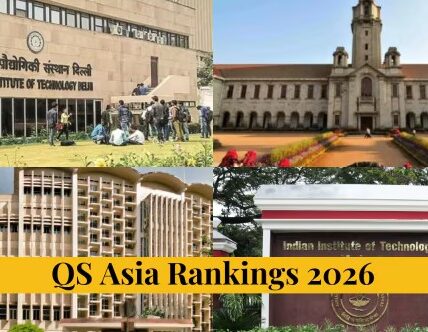Top IITs Slip as Universities from China, Singapore Surge Ahead: QS Asia Rankings 2026
India’s top IITs have seen their ranks fall in the QS Asia University Rankings 2026, while universities in China, Singapore, South Korea, and Malaysia climb higher. Seven IITs among the top 10 Indian institutions recorded their lowest positions in recent years.
IIT Delhi remained India’s highest-ranked university for the second consecutive year but dropped to 59th position, down from 44th in 2025. Other top IITs including IIT Madras, IIT Bombay, IIT Kanpur, and IIT Kharagpur also saw sharp declines.
The only Indian university to improve its rank was Chandigarh University, which rose from 120 to 109 this year.
QS Asia Rankings 2026: Top 10 Institutions
Globally, Hong Kong, China, and Singapore dominate the top 10 Asian universities:
| Rank | Institution |
| 1 | The University of Hong Kong |
| 2 | Peking University |
| =3 | National University of Singapore |
| =3 | Nanyang Technological University |
| 5 | Fudan University |
| 6 | The Hong Kong University of Science and Technology |
| =7 | The Chinese University of Hong Kong |
| =7 | City University of Hong Kong |
| 9 | Tsinghua University |
| 10 | The Hong Kong Polytechnic University |
QS noted an “eastward concentration of top performance”, reflecting growth in East and Southeast Asian higher education.
Why Indian IITs Dropped in Rankings
QS highlighted that Indian institutions face stiffer competition despite improving their overall scores. Metrics where IITs lag behind include:
- Citations per paper: IIT Delhi (31.5), IIT Bombay (20.0), IIT Madras (20.3)
- Faculty-student ratio: Ranges from 16.5 (IIT Kharagpur) to 40.9 (IIT Delhi)
- International student ratio: Scores range from 2.5 (IIT Kharagpur) to 12.3 (IIT Roorkee)
While IITs score high in academic reputation, employer reputation, staff with PhDs, and papers per faculty, regional peers outperform them in research impact, international collaborations, and global engagement.
Expanded Rankings and Rising Competition
The 2026 QS Asia Rankings now include 1,529 institutions, adding 552 new universities, with China contributing 261 new entries and India 137. This broader scope increased competition and introduced volatility in rankings.
QS emphasized that Indian universities remain strong in reputation but must improve research citations, faculty resources, and internationalization to compete with top Asian universities.




































